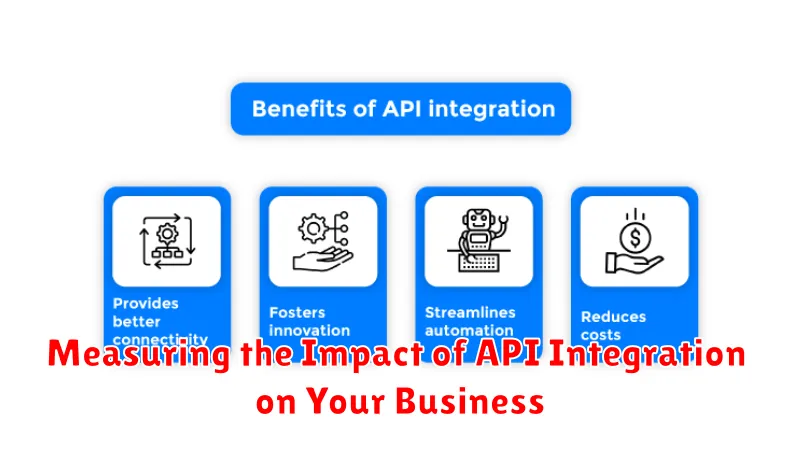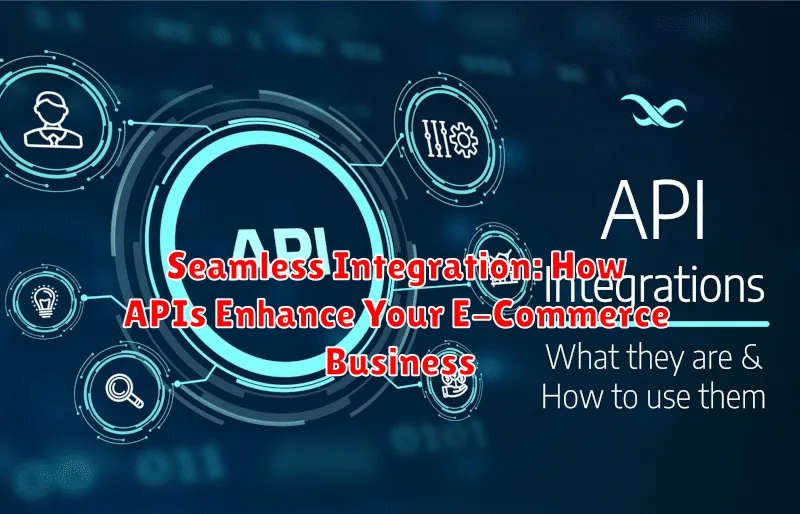In today’s interconnected digital landscape, Application Programming Interfaces (APIs) play a crucial role in fostering growth and efficiency across various industries, most notably within the realm of e-commerce. Seamless integration powered by APIs has revolutionized how online businesses operate, enabling them to connect disparate systems, streamline operations, and deliver enhanced customer experiences. This article explores the profound impact of API integration on e-commerce businesses, demonstrating how leveraging these powerful tools can lead to improved functionality, scalability, and ultimately, greater profitability.
From automating inventory management and order fulfillment to personalizing customer interactions and expanding marketing reach, the potential benefits of API integration for e-commerce are vast. By connecting your e-commerce platform to essential services like payment gateways, shipping providers, and CRM systems, you can unlock new levels of automation and efficiency. This article will delve into the specifics of how APIs enhance key aspects of your e-commerce business, providing practical insights and examples of successful integration strategies. Discover the transformative power of seamless integration and learn how APIs can propel your e-commerce business forward.
Understanding API Integration in E-Commerce
In the context of e-commerce, API integration refers to the connection between your online store and other software systems using Application Programming Interfaces (APIs). These APIs act as messengers, allowing different applications to communicate and exchange data seamlessly. This communication enables the automated transfer of information, such as product details, inventory levels, customer data, and order information, between your e-commerce platform and other crucial business systems.
Imagine your e-commerce platform as a central hub. APIs create the spokes that connect this hub to various other services, like your CRM, inventory management system, shipping provider, and payment gateway. This interconnectedness streamlines operations by eliminating manual data entry and ensuring data consistency across all platforms.
APIs essentially automate the flow of information, creating a more efficient and connected e-commerce ecosystem. Instead of manually updating information in multiple places, API integration allows these updates to happen automatically in real-time.
Benefits of API Integration for Online Stores
API integration offers numerous advantages for e-commerce businesses, streamlining operations and enhancing customer experiences. By connecting different software systems, APIs unlock a range of functionalities that drive growth and efficiency.
Improved Efficiency and Automation: APIs automate tasks such as inventory management, order fulfillment, and shipping updates, reducing manual effort and minimizing errors. This automation frees up resources, allowing your team to focus on strategic initiatives.
Enhanced Customer Experience: APIs enable personalized shopping experiences by integrating with customer relationship management (CRM) systems. This allows for targeted promotions, personalized recommendations, and streamlined customer service.
Real-Time Data Synchronization: Keep your online store up-to-date with real-time inventory levels, pricing, and product information. This prevents discrepancies and ensures accurate information is displayed to customers.
Scalability and Flexibility: APIs enable your business to adapt to changing market demands and scale operations efficiently. By seamlessly integrating with new technologies and platforms, you can stay ahead of the curve and expand your reach.
Types of APIs Commonly Used in E-Commerce
Several key API types are frequently employed in e-commerce to streamline operations and enhance functionality. Understanding these types is crucial for selecting the right API for your specific needs.
Payment Gateway APIs facilitate secure online transactions by connecting your e-commerce platform with payment processors. These APIs handle sensitive customer data and ensure smooth payment processing.
Shipping APIs connect your store with shipping carriers, providing real-time shipping rates, tracking information, and label generation capabilities. This automation simplifies logistics and improves order fulfillment.
Product Information APIs enable you to access and display detailed product data from suppliers or manufacturers. These APIs ensure up-to-date product information, including descriptions, specifications, and pricing.
Marketplace APIs allow you to integrate with online marketplaces like Amazon or eBay, expanding your reach and sales channels. These APIs manage inventory, orders, and customer interactions across multiple platforms.
Customer Relationship Management (CRM) APIs integrate your e-commerce platform with CRM systems, enabling personalized marketing campaigns and improved customer service by centralizing customer data.
Key Considerations for E-Commerce API Integration
Implementing APIs requires careful planning and execution. Security is paramount. Evaluate the API provider’s security measures, including authentication and data encryption, to protect sensitive customer information. Thoroughly test the integration to identify and address vulnerabilities.
Scalability is another crucial factor. Choose APIs that can handle your current and future transaction volumes. Consider the API’s ability to adapt to peak traffic and seasonal demands. A scalable API ensures smooth operations as your business grows.
Data mapping is essential for seamless data flow between systems. Ensure data fields align correctly between your e-commerce platform and the integrated applications. Accurate data mapping prevents errors and inconsistencies.
Error handling and monitoring are vital for maintaining a reliable integration. Implement robust error handling mechanisms to manage unexpected issues and minimize disruptions. Continuous monitoring allows you to track API performance and identify potential problems proactively.
Choosing the Right API for Your Business Needs

Selecting the appropriate APIs for your e-commerce platform requires careful consideration of your specific business requirements and goals. Scalability is crucial; choose APIs that can handle your current needs and future growth. Cost is another important factor, including initial setup fees, ongoing subscription costs, and usage-based charges.
Security is paramount when dealing with sensitive customer data. Ensure the API provider has robust security measures in place. Documentation and support are essential for successful integration and troubleshooting. Look for comprehensive documentation and responsive customer support.
Compatibility with your existing systems is vital for a seamless integration process. Evaluate the API’s compatibility with your e-commerce platform, CRM, and other relevant systems. Finally, consider the API’s features and functionalities, ensuring they align with your specific needs, such as inventory management, payment processing, or shipping integrations. Prioritize APIs that offer the functionalities that will best contribute to your business objectives.
Implementing API Integration: Best Practices
Thorough Planning is paramount. Define clear objectives for API integration. Identify the specific data points you need to exchange and the business processes you aim to automate.
API Documentation is your guide. Carefully review the provider’s documentation to understand the API’s functionalities, request formats, authentication methods, and rate limits.
Sandbox Environment. Utilize a sandbox environment for testing. This allows you to experiment with the API without affecting your live e-commerce data. Test different scenarios and edge cases to ensure smooth integration.
Secure Authentication is crucial. Implement robust authentication measures, such as API keys or OAuth 2.0, to protect your data and prevent unauthorized access.
Error Handling is essential. Develop comprehensive error handling mechanisms to gracefully manage potential issues like network failures or invalid requests. Log errors for debugging and monitoring purposes.
Gradual Rollout. Implement the API integration in stages. Start with a small subset of your e-commerce operations and gradually expand as you gain confidence in the integration’s stability and performance.
Troubleshooting Common API Integration Issues
API integration, while beneficial, can present challenges. Proactively addressing these issues is crucial for a smooth e-commerce operation.
One common problem is authentication errors. Verify API keys and secrets are correctly entered and haven’t expired. Check for typos or incorrect formatting.
Rate limiting is another frequent hurdle. If you’re exceeding the API provider’s allowed request frequency, implement strategies like request queuing or caching to manage the flow. Understand the provider’s rate limits and adjust your integration accordingly.
Data format inconsistencies can also cause problems. Ensure the data you’re sending and receiving aligns with the API’s expected format. Thoroughly test with various data types and scenarios.
Finally, unexpected errors can occur. Implement robust error handling to gracefully manage issues, log errors for debugging, and provide informative messages to users. Consult the API provider’s documentation for guidance on specific error codes.
Measuring the Impact of API Integration on Your Business

Measuring the success of API integration requires focusing on key performance indicators (KPIs) that directly reflect your business goals. Conversion rates are a crucial metric, showing how effectively integrated systems drive sales. Track changes in conversion rates before and after integration to quantify the impact.
Operational efficiency is another critical area. APIs can automate tasks, reducing manual work and saving time. Measure the time saved on specific processes, such as order fulfillment or customer support, to demonstrate increased efficiency. Look at metrics like order processing time or customer service response time.
Customer satisfaction is often improved through streamlined experiences provided by API integration. Analyze customer feedback and review scores to gauge the impact on customer happiness. An increase in positive reviews and higher satisfaction ratings can be attributed to a smoother, more integrated experience.
Finally, track the return on investment (ROI). Calculate the cost of API implementation and compare it to the financial benefits achieved through increased sales, reduced operational costs, and improved customer retention. This provides a clear picture of the overall impact of API integration on your bottom line.

